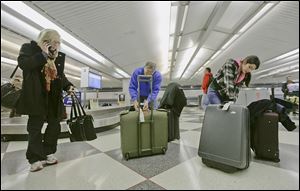
2012 DATA
Airline passenger complaints skyrocket
Rise happens as companies stuff more people into fewer planes
4/8/2013
Travelers check luggage at a United Airlines baggage claim area at O'Hare International Airport in Chicago. United Airlines had the highest consumer complaint rate of the 14 airlines in a report being released today: 4.24 complaints per 100,000 passengers.
WASHINGTON — Airline passengers are getting grumpier.
Airlines keep shrinking the size of seats to stuff more people onto planes, those empty middle seats that once provided a little more room are now occupied, and more people with tickets are being turned away because flights are overbooked.
Private researchers who analyzed federal data on airline performance also said in a report being released today that consumer complaints to the Department of Transportation surged one-fifth last year even though other measures such as on-time arrivals and mishandled baggage show airlines are doing a better job.
“The way airlines have taken 130-seat airplanes and expanded them to 150 seats to squeeze out more revenue I think is finally catching up with them,” said Dean Headley, a business professor at Wichita State University who has co-written the annual report for 23 years. “People are saying, ‘Look, I don’t fit here. Do something about this.’ At some point, airlines can’t keep shrinking seats to put more people into the same tube.”
The industry is even looking at ways to make the smaller-than-a-broom-closet toilets more compact in hopes of squeezing a few more seats onto planes.
“I can’t imagine the uproar that making toilets smaller might generate,” Mr. Headley said, especially given that passengers increasingly weigh more than they once did. “Will it keep them from flying? I doubt it would,” he said.
In recent years, some airlines have shifted to larger planes that can carry more people, but that hasn’t been enough to make up for an overall reduction in flights.
The rate at which passengers with tickets were denied seats because planes were full rose to 0.97 denials per 10,000 passengers last year, compared with 0.78 in 2011.
It used to be in cases of overbookings that airlines usually could find a passenger who would volunteer to give up a seat in exchange for cash, a free ticket, or other compensation with the expectation of catching another flight later that day or the next morning. Not anymore.
“Since flights are so full, there are no seats on those next flights. So people say, ‘No, not for $500, not for $1,000,’” airline industry analyst Robert Mann, Jr., said.
Regional carrier SkyWest had the highest involuntary denied boardings rate last year, 2.32 per 10,000 passengers.
But not every airline overbooks flights in an effort to keep seats full. JetBlue and Virgin America led the industry in avoiding denied boardings, with rates of 0.01 and 0.07, respectively.
United Airlines had the highest complaint rate of the 14 airlines in the report, with 4.24 complaints per 100,000 passengers. That was nearly double United’s complaint rate in 2011. Southwest had the lowest rate, 0.25.
Consumer complaints were significantly higher in the peak summer travel months of June, July, and August, when planes are especially crowded. “As airplanes get fuller, complaints get higher because people just don’t like to be sardines,” Mr. Mann said.
The complaints are regarded as indicators of a larger problem because many passengers may not realize they can file complaints with Transportation Department, which regulates airlines.
At the same time complaints increased, airlines did a better job of getting passengers to destinations on time. The industry average for on-time arrivals was 81.8 percent of flights, compared with 80 percent in 2011.
Hawaiian Airlines had the best on-time performance record, 93.4 percent in 2012. ExpressJet and American Airlines had the worst: only 76.9 percent of their planes arrived on time last year.
The industry’s on-time performance has improved in recent years, partly because of airlines’ decision to cut back on the number of flights.
The report’s ratings are based on statistics kept by the department for airlines that carry at least 1 percent of the passengers who flew domestically last year.
The airlines covered in the report are AirTran, Alaska, American, American Eagle, Delta, ExpressJet, Frontier, Hawaiian, JetBlue, SkyWest, Southwest, United, US Airways, and Virgin America.